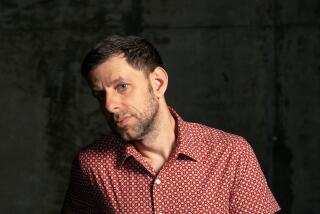Raiford Rogers Modern Ballet at the Luckman Theatre
Choreographer Raiford Rogers doesn’t shy away from tough music. His two newest works, danced strongly by his company Saturday at Cal State L.A.’s Luckman Theatre, draw on one of Beethoven’s last, far-reaching string quartets.
The new pieces were “Grosse Fuge,” the original finale of the String Quartet No. 13 in B-flat, Opus 130, which the composer replaced after the 1826 premiere audience complained of its length; and “Cavatina,” the fifth movement of the same quartet.
Rogers actually reversed Beethoven’s original order of the movements, thus moving from an austere, often relentless and titanic struggle with an abstract musical form to a feeling of quiet resolution, acceptance and peace.
The choreographer linked the two pieces by using similar signature movement motifs, some of which were initiated by dancers Lisa Gillespie and Bobby Briscoe. The recurring moves included slow stretches, turns in arabesques, arched backs, cantilevered balances and extensions to the side.
The motifs were played, varied and overlaid as dancers rapidly crossed and re-crossed the Luckman stage to the complex music.
The choreography had no overt emotion, no climactic moment, no play for big effects, except for an occasional although ambiguous use of stage smoke. It was all an intelligent response to the score. For all that, one would have liked to have liked the piece more.
Tekla Kostek and Briscoe began the gentle “Cavatina” with tender partnering. She was vulnerable in relying on his presence, and he offered strong but unself-dramatized support. Their closeness was more properly recognized when they were replaced later by a group of women who had no male partners.
The program, all danced to recorded music, also included “Prelude in Green, Adagio in Blue” and “Transcription No. 2 Passacaglia,” both from 2007. In the first part of “Prelude,” danced to a Corelli sonata, Jamie Dee and Christian Broomhall were the lyrical couple in green; in the second, danced to a Bach adagio, the dramatic Gillespie was again partnered by Briscoe.
All 11 dancers appeared in “Transcription,” created to Max Reger’s two-piano version of Bach’s Passacaglia and Fugue in C minor, which closed the program. Again, the choreography was clean, intelligent, proportioned -- but lacking in the music’s high drama.
Rogers hears and respects music. He says in a program note that his ballets are “transcriptions created by visualizing the inner narrative, or idea, of the music.” The choreography, he says further, is “formed by uncovering the intent, or psychology, of the score and transcribing it into pure movement.” Unfortunately, the results too often look respectable but rather cool.
More to Read
The biggest entertainment stories
Get our big stories about Hollywood, film, television, music, arts, culture and more right in your inbox as soon as they publish.
You may occasionally receive promotional content from the Los Angeles Times.










